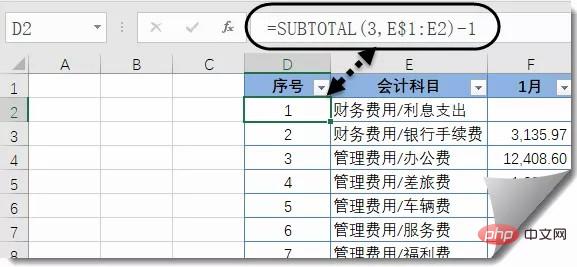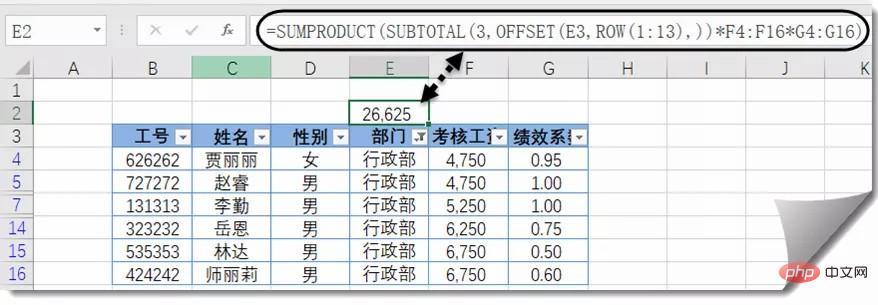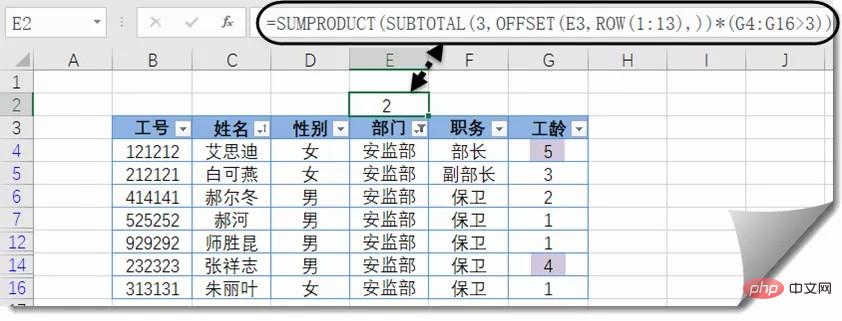Calculation summary in Excel filtering state
This article brings you relevant knowledge about excel. It mainly introduces how to add serial numbers after filtering, multiply after filtering, and count according to conditions after filtering. Let’s take a look at it together. I hope it helps everyone.

Related learning recommendations: excel tutorial
1. Add the serial number after filtering
as shown in the figure below, To maintain continuous serial numbers in the filtered state, we can cancel the filter first, enter the following formula in cell D2, and then pull down:
=SUBTOTAL(3,E$1:E2)-1

The SUBTOTAL function only counts visible cell contents.
Using 3 for the first parameter indicates the calculation rule for executing the COUNTA function, that is, counting the number of visible cells for the second parameter.
The second parameter uses a dynamically expanded range E$1:E2. As the formula is pulled down, this range will become E$1:E3, E$1:E4, E$1:E5,...
The formula always calculates the number of visible non-empty cells in the area from the first row of column E to the row where the formula is located. Subtract 1 from the result, and the calculated result will be the same as the serial number, and it will remain continuous after filtering.
Note, please note that if this formula is changed to =SUBTOTAL(3,E$2:E2), that is, starting from the row where the formula is located, the serial number result will be fine, but the last row will be filtered by Excel. Always displayed as a summary row.
2. Multiply after filtering
As shown in the figure below, after filtering column E, you need to calculate the total amount multiplied by the unit price.
The formula in cell E2 is:
=SUMPRODUCT(SUBTOTAL(3,OFFSET(E3,ROW(1:13),))*F4:F16*G4:G16)

To calculate the filtered product, the key to the problem is to determine whether the data is visible.
How to judge this visible status?
Need to combine OFFSET and SUBTOTAL functions.
First use the OFFSET function, taking cell E3 as the base point, and offset rows 1 to 13 downwards in order to obtain a multi-dimensional reference. This multi-dimensional reference contains 13 reference areas with one row and one column, that is, individual cells from E4 to E16 are referenced respectively.
Next use the SUBTOTAL function, use 3 as the first parameter, that is, count the number of visible cells in each cell from E4 to E16 in sequence. If the cell is in the display state, count this cell. The result is 1, otherwise the statistical result is 0. Get a memory array with the following effect:
{1;0;1;1;1;1;0;0;1;1;0;1;0}
Use the above again The result is multiplied by the quantity in column F and the unit price in column G. If the cell is in the display state, it is equivalent to 1*quantity*unit price, otherwise it is equivalent to 0*quantity*unit price.
Finally use the SUMPRODUCT function to sum the products.
3. Count according to conditions after filtering
As shown in the figure below, after filtering the departments in column E, the number of people with more than 3 years of service must be calculated.
The formula in cell E2 is:
=SUMPRODUCT(SUBTOTAL(3,OFFSET(E3,ROW(1:13),))*(G4:G16>3))

The first half of the calculation principle is the same as the previous example, and the core is to determine whether the cell is visible.
The statistical conditions in the second half of the formula (G4:G16>3) are multiplied by the judgment results in the first half, indicating that both conditions are met at the same time, that is, the number of items in the visible state and column G is greater than 3 .
4. Automatically correct the title after filtering
As shown in the figure below, after filtering the department name in column E, you want the title of cell D1 to automatically change to the corresponding department name. The formula is:
=LOOKUP(1,0/SUBTOTAL(3,OFFSET(D1,ROW(1:15)-1,)),E:E)&”Statistics Table”

The combination of SUBTOTAL and OFFSET functions still aims to determine whether the cells in column D are visible. Get a memory array composed of 0 and 1:
{0;1;0;0;0;0;1;1;1;1;0;1;0;1;0}
Use the memory array 0/ to get a new memory array composed of 0 and error value:
{#DIV/0!;0;#DIV/0!…;0;0;0 ;0;#DIV/0!;0;#DIV/0!;0;#DIV/0!}
The LOOKUP function uses 1 as the query value to find the position of the last 0 in the above memory array , and returns the contents of column E at the corresponding position.
The ultimate goal is to extract the content of the last displayed cell after filtering.
Connect the extracted content with "statistical table" and turn it into an automatically updated table title.
Related learning recommendations: excel tutorial
The above is the detailed content of Calculation summary in Excel filtering state. For more information, please follow other related articles on the PHP Chinese website!

Hot AI Tools

Undresser.AI Undress
AI-powered app for creating realistic nude photos

AI Clothes Remover
Online AI tool for removing clothes from photos.

Undress AI Tool
Undress images for free

Clothoff.io
AI clothes remover

AI Hentai Generator
Generate AI Hentai for free.

Hot Article

Hot Tools

Notepad++7.3.1
Easy-to-use and free code editor

SublimeText3 Chinese version
Chinese version, very easy to use

Zend Studio 13.0.1
Powerful PHP integrated development environment

Dreamweaver CS6
Visual web development tools

SublimeText3 Mac version
God-level code editing software (SublimeText3)

Hot Topics
 1378
1378
 52
52
 What should I do if the frame line disappears when printing in Excel?
Mar 21, 2024 am 09:50 AM
What should I do if the frame line disappears when printing in Excel?
Mar 21, 2024 am 09:50 AM
If when opening a file that needs to be printed, we will find that the table frame line has disappeared for some reason in the print preview. When encountering such a situation, we must deal with it in time. If this also appears in your print file If you have questions like this, then join the editor to learn the following course: What should I do if the frame line disappears when printing a table in Excel? 1. Open a file that needs to be printed, as shown in the figure below. 2. Select all required content areas, as shown in the figure below. 3. Right-click the mouse and select the "Format Cells" option, as shown in the figure below. 4. Click the “Border” option at the top of the window, as shown in the figure below. 5. Select the thin solid line pattern in the line style on the left, as shown in the figure below. 6. Select "Outer Border"
 How to filter more than 3 keywords at the same time in excel
Mar 21, 2024 pm 03:16 PM
How to filter more than 3 keywords at the same time in excel
Mar 21, 2024 pm 03:16 PM
Excel is often used to process data in daily office work, and it is often necessary to use the "filter" function. When we choose to perform "filtering" in Excel, we can only filter up to two conditions for the same column. So, do you know how to filter more than 3 keywords at the same time in Excel? Next, let me demonstrate it to you. The first method is to gradually add the conditions to the filter. If you want to filter out three qualifying details at the same time, you first need to filter out one of them step by step. At the beginning, you can first filter out employees with the surname "Wang" based on the conditions. Then click [OK], and then check [Add current selection to filter] in the filter results. The steps are as follows. Similarly, perform filtering separately again
 How to change excel table compatibility mode to normal mode
Mar 20, 2024 pm 08:01 PM
How to change excel table compatibility mode to normal mode
Mar 20, 2024 pm 08:01 PM
In our daily work and study, we copy Excel files from others, open them to add content or re-edit them, and then save them. Sometimes a compatibility check dialog box will appear, which is very troublesome. I don’t know Excel software. , can it be changed to normal mode? So below, the editor will bring you detailed steps to solve this problem, let us learn together. Finally, be sure to remember to save it. 1. Open a worksheet and display an additional compatibility mode in the name of the worksheet, as shown in the figure. 2. In this worksheet, after modifying the content and saving it, the dialog box of the compatibility checker always pops up. It is very troublesome to see this page, as shown in the figure. 3. Click the Office button, click Save As, and then
 How to type subscript in excel
Mar 20, 2024 am 11:31 AM
How to type subscript in excel
Mar 20, 2024 am 11:31 AM
eWe often use Excel to make some data tables and the like. Sometimes when entering parameter values, we need to superscript or subscript a certain number. For example, mathematical formulas are often used. So how do you type the subscript in Excel? ?Let’s take a look at the detailed steps: 1. Superscript method: 1. First, enter a3 (3 is superscript) in Excel. 2. Select the number "3", right-click and select "Format Cells". 3. Click "Superscript" and then "OK". 4. Look, the effect is like this. 2. Subscript method: 1. Similar to the superscript setting method, enter "ln310" (3 is the subscript) in the cell, select the number "3", right-click and select "Format Cells". 2. Check "Subscript" and click "OK"
 How to set superscript in excel
Mar 20, 2024 pm 04:30 PM
How to set superscript in excel
Mar 20, 2024 pm 04:30 PM
When processing data, sometimes we encounter data that contains various symbols such as multiples, temperatures, etc. Do you know how to set superscripts in Excel? When we use Excel to process data, if we do not set superscripts, it will make it more troublesome to enter a lot of our data. Today, the editor will bring you the specific setting method of excel superscript. 1. First, let us open the Microsoft Office Excel document on the desktop and select the text that needs to be modified into superscript, as shown in the figure. 2. Then, right-click and select the "Format Cells" option in the menu that appears after clicking, as shown in the figure. 3. Next, in the “Format Cells” dialog box that pops up automatically
 How to use the iif function in excel
Mar 20, 2024 pm 06:10 PM
How to use the iif function in excel
Mar 20, 2024 pm 06:10 PM
Most users use Excel to process table data. In fact, Excel also has a VBA program. Apart from experts, not many users have used this function. The iif function is often used when writing in VBA. It is actually the same as if The functions of the functions are similar. Let me introduce to you the usage of the iif function. There are iif functions in SQL statements and VBA code in Excel. The iif function is similar to the IF function in the excel worksheet. It performs true and false value judgment and returns different results based on the logically calculated true and false values. IF function usage is (condition, yes, no). IF statement and IIF function in VBA. The former IF statement is a control statement that can execute different statements according to conditions. The latter
 Where to set excel reading mode
Mar 21, 2024 am 08:40 AM
Where to set excel reading mode
Mar 21, 2024 am 08:40 AM
In the study of software, we are accustomed to using excel, not only because it is convenient, but also because it can meet a variety of formats needed in actual work, and excel is very flexible to use, and there is a mode that is convenient for reading. Today I brought For everyone: where to set the excel reading mode. 1. Turn on the computer, then open the Excel application and find the target data. 2. There are two ways to set the reading mode in Excel. The first one: In Excel, there are a large number of convenient processing methods distributed in the Excel layout. In the lower right corner of Excel, there is a shortcut to set the reading mode. Find the pattern of the cross mark and click it to enter the reading mode. There is a small three-dimensional mark on the right side of the cross mark.
 How to insert excel icons into PPT slides
Mar 26, 2024 pm 05:40 PM
How to insert excel icons into PPT slides
Mar 26, 2024 pm 05:40 PM
1. Open the PPT and turn the page to the page where you need to insert the excel icon. Click the Insert tab. 2. Click [Object]. 3. The following dialog box will pop up. 4. Click [Create from file] and click [Browse]. 5. Select the excel table to be inserted. 6. Click OK and the following page will pop up. 7. Check [Show as icon]. 8. Click OK.




